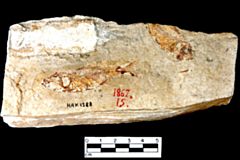Project 5175: M. Chang, J. G. Maisey. 2003. Redescription of Ellimma branneri and Diplomystus shengliensis, and Relationships of Some Basal Clupeomorphs. American Museum Novitates. 3404 (1):1.
Abstract
Two extinct clupeomorphs, †Ellimma branneri from the Cretaceous of Brazil and †Diplomystus shengliensis from the Eocene of China, are redescribed. †Ellimma branneri was formerly classified within the Clupeiformes, but it lacks derived characters of clupeiforms and clupeoids. Dorsal scute “wings” are expanded and subrectangular in †Ellimma and other members of the family †Paraclupeidae Chang and Chou (1977), approximately equal to †Ellimmichthyidae Grande (1982a). Consequently, †Ellimma branneri is classified here within the family †Paraclupeidae. †Paraclupeidae are known from the Lower Cretaceous to the middle Eocene. In the present work, two monophyletic groups are identified within the †Paraclupeidae. One group (subfamily †Paraclupeinae of Chang and Grande, 1997), known only from the Lower Cretaceous (Hauterivian–Albian), includes †Paraclupea, †Ellimmichthys, and †Ellimma. These taxa are united by strongly sculptured, skull-roofing bones with ridges radiating from the growth center, and a dorsal scute ornament of prominent ridges. †Scutatuspinosus may also belong in this group. The other group includes †Diplomystus (Upper Cretaceous–Eocene) and †Armigatus (Upper Cretaceous), which are united by a single homoplaseous character (presence of a posteriorly expanded third hypural, leaving no gap between hypurals 2 and 4): this character also occurs in pristigasteroids, †Erichalcis, osteoglossids, some elopomorphs (†Lebanichthys lewisi, and most Albula spp.), and a number of ostariophysans not included in our analysis. †Paraclupeines are customarily regarded as being more closely related to the Clupeiformes than to other teleosts (i.e., as clupeomorphs), although no derived characters are uniquely shared by †Ellimma branneri and modern Clupeiformes. The relationships of †Ellimma and certain other extinct herring-like teleosts (including other †paraclupeines) with the Clupeiformes are unclear, and they may collectively form a paraphyletic assemblage. No biogeographical hypothesis satisfactorily explains the known distribution of nonmarine †paraclupeine fishes in the Cretaceous. A substantial portion of their nonmarine fossil record is missing (as evidenced by the recent discovery of a possible †paraclupeine, †Ezkutuberezi carmeni Poyato-Ariza et al., 2000, in Spain), and some aspects of their early distribution pattern may have involved marine dispersal. Eocene †Diplomystus occurs on both sides of the Pacific Ocean, but the “Pacifica” hypothesis (which lacks empirical support) is abandoned as an explanation for such Eocene (and younger) trans-Pacific distribution patterns of nonmarine fishes. Instead, a “freshwater Arctic Ocean” hypothesis is favored. According to this hypothesis (for which there are several independent lines of geological evidence), temporary desalination of the Arctic Ocean occurred during the Paleocene and early Eocene, which may have permitted freshwater fishes to move unimpeded by salt-water barriers between Asia and North America; this temporary desalination event may eventually become recognized as a significant factor in the holarctic distribution patterns of various Tertiary-Recent freshwater fishes.Read the article »
Article DOI: 10.1206/0003-0082(2003)404<0001:ROEBAD>2.0.CO;2
Project DOI: 10.7934/P5175, http://dx.doi.org/10.7934/P5175
| This project contains | Matrices |
|---|---|
Download Project SDD File | Total scored cells: 314 Total media associated with cells: 0 Total labels associated with cell media: 0 |
| Characters | |
| Total characters: 30 Total characters with associated media: 0 Total characters with media with labels: 0 Total character states: 61 Total character states with associated media: 0 Total character states with media with labels:0 Total unordered/ordered characters:30/0 |
Currently Viewing:
MorphoBank Project 5175
MorphoBank Project 5175
- Creation Date:
29 March 2024 - Publication Date:
08 April 2024
Authors' Institutions ![]()
- Chinese Academy of Sciences
- American Museum of Natural History (AMNH)
Members
| member name | taxa |
specimens |
media | chars | character
| cell scorings (scored, NPA, "-") | cell
| rules | ||||||
| Shreya Jariwala Project Administrator | 11 | 4 | 4 | 30 | 0 | 0 | 314 (309, 0, 5) | 0 | 0 | 0 | ||||
Taxonomic Overview for Matrix 'M29767' (11 Taxa)
| taxon | unscored cells |
scored cells |
no cell support |
NPA cells |
"-" cells | cell images | labels on cell images |
member access |
| [1] † Armigatus Taxon name last Modified on 03/29/24 | 1 | 29 | 29 | 0 | 0 | 0 | 0 | 1 |
| [2] † Clupea Taxon name last Modified on 03/29/24 | 0 | 29 | 29 | 0 | 1 | 0 | 0 | 1 |
| [3] Denticeps Taxon name last Modified on 03/29/24 | 0 | 29 | 29 | 0 | 1 | 0 | 0 | 1 |
| [4] † Diplomystus shengliensis Taxon name last Modified on 03/29/24 | 0 | 30 | 30 | 0 | 0 | 0 | 0 | 1 |
| [5] † Ellimma branneri Taxon name last Modified on 03/29/24 | 4 | 26 | 26 | 0 | 0 | 0 | 0 | 1 |
| [6] † Ellimmichthys Taxon name last Modified on 03/29/24 | 5 | 25 | 25 | 0 | 0 | 0 | 0 | 1 |
| [7] † Elops Taxon name last Modified on 03/29/24 | 0 | 29 | 29 | 0 | 1 | 0 | 0 | 1 |
| [8] † Knightia Taxon name last Modified on 03/29/24 | 1 | 29 | 29 | 0 | 0 | 0 | 0 | 1 |
| [9] † Paraclupea Taxon name last Modified on 03/29/24 | 3 | 27 | 27 | 0 | 0 | 0 | 0 | 1 |
| [10] † Onchorhynchus Taxon name last Modified on 03/29/24 | 0 | 29 | 29 | 0 | 1 | 0 | 0 | 1 |
| [11] † Santanaclupea Taxon name last Modified on 03/29/24 | 2 | 27 | 27 | 0 | 1 | 0 | 0 | 1 |

